What brings people to walk long distances over rough terrain, carrying heavy packs?
Why leave behind the campground with running water for a much rougher, wilder camping experience?
Peace, quiet, wildlife sightings, challenging exercise, wanderlust, sunrises, and sunsets -- the list goes on.
Backpacking is an adventure that brings together the experience of hiking and primitive camping.
The reward for lugging all your gear far into the wilds is spending your nights under the stars -- or clouds. With so many people taking to the outdoors, it also provides an opportunity to spread out and find a less crowded situation.
There are thousands of miles of hiking trails in Pennsylvania, offering abundant backpacking possibilities.
Specifically, there are almost 800 miles of designated state forest hiking trails travelling a variety of terrain and skill levels.
Whether you are a seasoned backpacker or someone just starting out, Pennsylvania state forests are an ideal place to leave the busy world behind and take on the challenge of a backpacking trip.
Variety of Trails for All Skill Levels
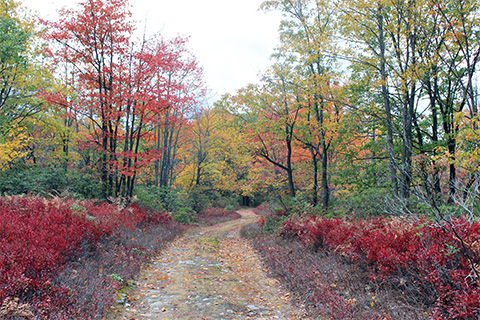
Some trails follow old logging and wagon roads and are fairly level.
Backpacking doesn’t have to be an extended, strenuous trip -- unless you want it to.
Thousands of people each year decide to tackle the 2,000-mile Appalachian Trail, committing to months of living out of a tent, hammock, or shelter. But even they had to start somewhere.
Don’t rule it out before trying it. Backpacking is an activity for all ages and abilities.
Most state forest districts have trails suitable for backpacking and can provide maps and information to help you plan your hike.
Many of DCNR’s designated state forest hiking trails are great for a backpacking trip, and take the guess work out of finding the right route.
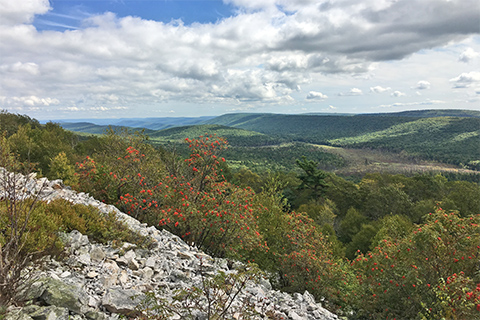
The Mid State Trail leads to many vistas, and is often rocky and steep.
Some trails are loop trails that circle back to your starting point. Others travel end to end and require a vehicle to shuttle hikers back and forth. You can also utilize the many side trails to create your own loops to explore as much or as little as you would like.
Campsites and some backpacking shelters can be found along these trails, but most offer only a flat place to pitch a tent.
DCNR state forest trails range from fairly level, old logging roads to steep, rocky paths scaling the sides of mountains. The difficulty of the trails varies, and there is something for everyone.
Some trails are great for beginners and families, while other trails appeal to the experienced backpacker.
Waterfalls, vistas, wildflower blooms, fall foliage, and big game sightings are all possible highlights while backpacking in state forests.
Primitive Camping Along the Trail
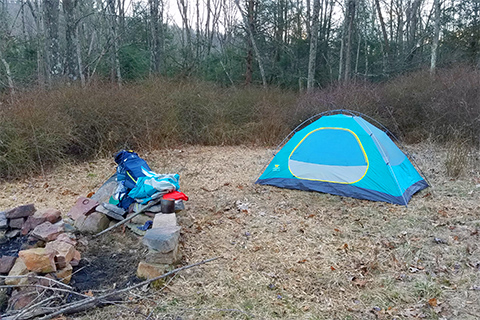
A primitive site is often no more than a flat spot and fire ring.
Interest in camping is strong right now, and many people are just getting started. It’s important to plan ahead and be prepared so you don’t have an uncomfortable, or maybe even risky experience.
At the end of a long day’s hike, it’s important to have a good meal and get a good night’s rest to refuel for the next day.
You won’t find the amenities and comforts of a state park campground, or noisy generators either.

Hammocks take advantage of trees in rocky and sloped areas.
It’s up to you to make sure you have everything you need to make and prepare food and have a comfortable night’s sleep.
Tents and sleeping bags should be rated for the season when you are backpacking to ensure you stay warm enough at night.
When looking for a place to set up camp, there’s a few things to keep in mind to help keep that campsite in a natural state to be enjoyed by others.
If planning on staying more than one night at a primitive campsite, a free camping permit from the state forest district is needed. Contacting the state forest district ahead of time is always encouraged, for safety purposes.
All visitors to Pennsylvania’s state forests should practice Leave No Trace principles, minimizing your impact on a site. Some popular sites become over-used, leading to soil compaction, trampling of plants, and a buildup of litter.
Try to avoid camping in these heavily impacted areas, and don’t build new campfire rings.
It’s best to consult a trail guidebook or the state forest district office to find information on established campsites.
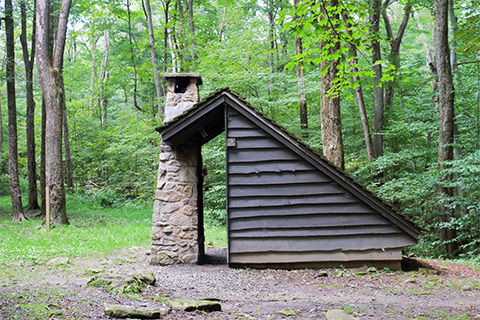
Shelters like this one can be reserved along the Laurel Highlands Hiking Trail.
One way to help reduce impact is to use a backpacking stove rather than a campfire to boil water and cook food. There are many types of stoves using a variety of fuels that are suited for different conditions.
This cuts down on the amount of wood taken for firewood and reduces the risk of wildfire. It also makes cooking easier and cleaner, leaving more time to enjoy at camp or on the trail.
If you want to indulge in a campfire, check with the forest district and pay attention to the current wildfire danger rating. To prevent wildfires, campfires are prohibited each spring from March 1 through May 25.
Backpacking Safety Tips
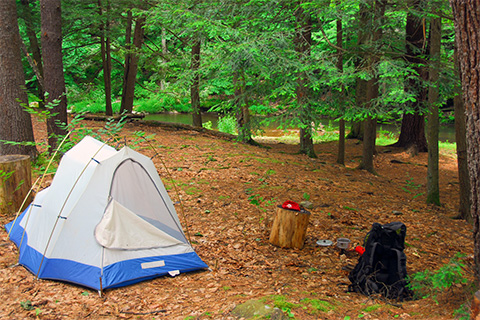
Being far from the stresses of the world also means being far from emergency services, so safety in the backcountry should always be a top priority.
And with so much to think about, just planning a trip may seem overwhelming.
If you are preparing for your first backpacking trip, here are some tips to keep in mind:
- Choose an easy destination -- Short, overnight hikes are best to start out.
- Plan your food -- It’s important to fuel your body while you hike. High-calorie, just-add-water meals can be found at outdoor stores, and other easy-to-cook options at local grocery stores. Be sure to pack plenty of snacks!
- Be prepared -- Make sure you have the supplies you need to be safe. The 10 Essentials is a helpful list to make sure you have the basics covered. Condition yourself to do the planned hike with a fully loaded pack.
- Pre-check your gear -- Make sure your boots, pack, and other gear fit and work properly before you hit the trail. As a general rule, a loaded backpacking pack should not weigh more than about 20 percent of your body weight. (If you weigh 150 pounds, your pack should not exceed 30 pounds for backpacking.)
- Safety in numbers -- Always try to hike with a buddy. If you really want the solo experience, make sure you let someone know where you are going and when you plan to be back.
- Do your research -- Learn about the trail you plan to hike and be mindful of trail conditions, such as water levels at stream crossings or water availability at springs. Check the weather forecast. Consider hunting seasons and whether fluorescent orange should be worn. Brush up on Leave No Trace principles.
Backpacking Resources

There is a large, active backpacking community in Pennsylvania made of trail clubs, volunteers, and passionate hikers.
If you are new to backpacking and aren’t sure where to start, check to see if there is a local trail near you.
Most of the hiking trails in Pennsylvania are maintained by volunteer organizations who offer guidebooks and trail information.
The Keystone Trails Association and its chapters of trail clubs, and the Appalachian Trail Conservancy are good places to start if you are interested in finding a local trail club.
You can learn more about each of DCNR’s designated state forest hiking trails and forest districts on the DCNR website.
Designated state forest hiking trails can also be found on the DCNR interactive map.